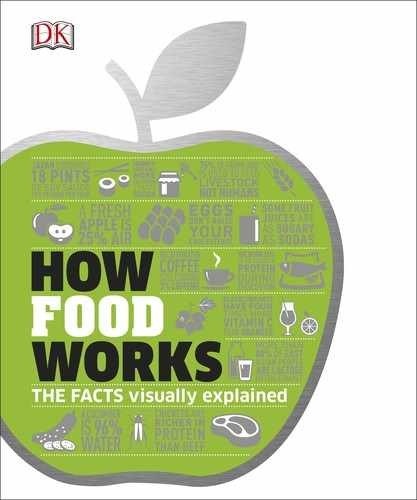
TYPES OF FOOD
Shellfish
Shellfish
Colossal heaps of discarded shells at prehistoric sites
attest to the historic importance of shellfish in the
human diet, and today this diverse group of aquatic
organisms is still a valuable source of nutrition.
The value of shellfish
Shellfish—crustaceans such as crabs and shrimp, and mollusks such as
oysters and octopus—are a superfood category all of their own, being an
excellent source of lean protein. They are also rich in B vitamins, iodine,
and calcium. From a flavor point of view, seafood is rich in tasty amino
acids, such as glycine, which tastes sweet, and umami (savory) glutamate.
WHY DOES
COOKING CRUSTACEANS
TURN THEM RED?
The shells of crustaceans
contain carotenoid pigments
linked to proteins. Cooking
alters the proteins, releasing
the reddish-colored
carotenoids.
PERCENTAGE OF FAT, BY WEIGHT
PERCENTAGE OF PROTEIN, BY WEIGHT
10%
0
5%
10%
15%
20%
15% 20%
ABOUT ONE-THIRD
OF THE WARM-WATER
SHRIMP HARVEST
IS FARMED RATHER
THAN FROM
WILD STOCKS
APHRODISIACS
Raw oysters have a historic
reputation as an aphrodisiac, and
there is some evidence that this
reputation may be justified. They
are high in zinc, which aids male
fertility, and have also been
found to contain amino acids
that can trigger the release of sex
hormones in men and women.
Crab meat contains
a similar proportion
of protein and fat
to shrimp
Scallops have little fat
but also a fairly small
amount of protein
High protein, low fat
Compared to the meat of land animals, most crustaceans and
mollusks offer high protein for little fat. Their meat protein
also offers a contrast in texture with land-animal red meat,
because it is white muscle packaged with high levels of the
protein collagen, making it firm and moist. In contrast, red
meat contains high levels of the protein myoglobin, which
give the meat its red color, and lower levels of collagen.
SQUID
SHRIMP
CRAB
SCALLOP
OYSTER
US_080-081_Seafood.indd 80 27/02/2017 12:32
80 81
TYPES OF FOOD
Shellfish
PERCENTAGE OF PROTEIN, BY WEIGHT
25% 30%
Seasonal toxicity
The summer months
are often the worst
for toxic blooms of
algae and for harmful
microorganisms,
which proliferate in
warmer waters and
can accumulate in
filter feeders, such
as many mollusks
and crustaceans.
Paralytic shellfish poisoning
Numbness and tingling, loss
of coordination, difficulty
speaking, nausea, vomiting.
May be fatal.
Amnesiac shellfish poisoning
Memory problems, which
may be long term, or even
permanent brain damage.
May be fatal.
Shellfish poisoning
Many shellfish feed by filtering
out food particles from the water.
However, they also trap toxins
and microbes, which may build
up and, if enough contaminated
shellfish are eaten, may cause
poisoning. The toxins are not
destroyed by cooking. Symptoms
of the main types of shellfish
poisoning are outlined below.
Diarrheal shellfish poisoning
Diarrhea, nausea, vomiting,
abdominal pain. No known
fatalities.
Neurotoxic shellfish poisoning
Nausea, vomiting, slurred speech.
No known fatalities.
SPRING SUMMER FALL WINTER
Nontoxic
algae
Toxic algae
Lower levels
of algal toxins
Octopus meat is one
of the best sources of
low-fat protein
High levels of
algal toxins
When to eat shellfish
Many types of shellfish are best
avoided at certain times of the year,
for a number of reasons. First, many
species breed in the summer and
expend their energy reserves during
this period, becoming meager and
less tasty. Second, summer is also
the period when toxin levels are
highest. The best period for eating
many shellfish is during the winter
months, when they are fattening up in
preparation for the breeding season
and when toxin levels are low.
Lamb has a high
percentage of fat in
relation to protein
LOBSTER
OCTOPUS
CHICKEN
BEEF
LAMB
KEY
Safe
Dangerous
US_080-081_Seafood.indd 81 18/01/2017 09:43

80 81
TYPES OF FOOD
Shellfish
PERCENTAGE OF PROTEIN, BY WEIGHT
25% 30%
Seasonal toxicity
The summer months
are often the worst
for toxic blooms of
algae and for harmful
microorganisms,
which proliferate in
warmer waters and
can accumulate in
filter feeders, such
as many mollusks
and crustaceans.
Paralytic shellfish poisoning
Numbness and tingling, loss
of coordination, difficulty
speaking, nausea, vomiting.
May be fatal.
Amnesiac shellfish poisoning
Memory problems, which
may be long term, or even
permanent brain damage.
May be fatal.
Shellfish poisoning
Many shellfish feed by filtering
out food particles from the water.
However, they also trap toxins
and microbes, which may build
up and, if enough contaminated
shellfish are eaten, may cause
poisoning. The toxins are not
destroyed by cooking. Symptoms
of the main types of shellfish
poisoning are outlined below.
Diarrheal shellfish poisoning
Diarrhea, nausea, vomiting,
abdominal pain. No known
fatalities.
Neurotoxic shellfish poisoning
Nausea, vomiting, slurred speech.
No known fatalities.
SPRING SUMMER FALL WINTER
Nontoxic
algae
Toxic algae
Lower levels
of algal toxins
Octopus meat is one
of the best sources of
low-fat protein
High levels of
algal toxins
When to eat shellfish
Many types of shellfish are best
avoided at certain times of the year,
for a number of reasons. First, many
species breed in the summer and
expend their energy reserves during
this period, becoming meager and
less tasty. Second, summer is also
the period when toxin levels are
highest. The best period for eating
many shellfish is during the winter
months, when they are fattening up in
preparation for the breeding season
and when toxin levels are low.
Lamb has a high
percentage of fat in
relation to protein
LOBSTER
OCTOPUS
CHICKEN
BEEF
LAMB
KEY
Safe
Dangerous
US_080-081_Seafood.indd 81 18/01/2017 09:43
..................Content has been hidden....................
You can't read the all page of ebook, please click here login for view all page.
